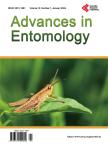Potential of Two <i>Metarhizium anisopliae</i>(Clavicipitaceae) Isolates for Biological Control of <i>Diatraea saccharalis</i>(Lepidoptera: Crambidae) Eggs
Potential of Two <i>Metarhizium anisopliae</i>(Clavicipitaceae) Isolates for Biological Control of <i>Diatraea saccharalis</i>(Lepidoptera: Crambidae) Eggs作者机构:Laboratory of Biological Control Morphology and Cytogenetics of Insects Department of Biotechnology Genetics and Cell Biology State University of Maringá (UEM) Maringá Paraná Brazil Laboratory of Microbial Biotechnology Department of Biotechnology Genetics and Cell Biology State University of Maringá (UEM) Maringá Paraná Brazil
出 版 物:《Advances in Entomology》 (昆虫学(英文))
年 卷 期:2022年第10卷第1期
页 面:63-76页
学科分类:07[理学] 0701[理学-数学] 070101[理学-基础数学]
主 题:Entomopathogen Fungi Management Sugarcane Sustainability
摘 要:Chemical pesticides tend to accumulate in soil, resulting in human and environmental health risks. Hence, alternative methodologies involving chemical pesticides are beneficial for the control of agricultural pests. Metarhizium anisopliae is an entomopathogenic fungus that acts on different developmental stages of pest insects such as Diatraea saccharalis, a holometabolic lepidopteran with high potential for infestation in sugarcane crops. The present study evaluated the biocontrol effect of M. anisopliae isolates MT and E9 on D. saccharalis eggs at different ages by investigating the external and internal morphological alterations in treated eggs. Conidial suspensions of M. anisopliae isolated from MT and E9 at concentrations of 107 conidia/mL were applied to eggs of D. saccharalis aged 0, 24, 48, 72, 96 and 120 h. The eggs were observed every 24 h during development (0 h to 144 h). Samples were collected for observational, histological, and ultrastructural analyses. We found that the MT isolate caused 100% inviability of eggs aged 0 - 72 h, 144 h after the bioassays, while the effect of the E9 isolate varied between 49.40% and 93.75%. M



